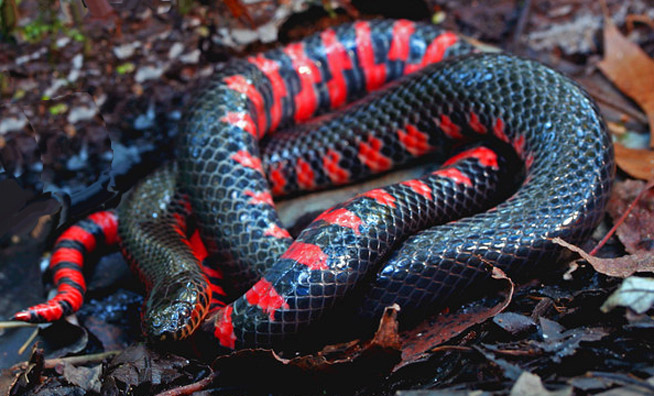
Biology:
The Mud snake is a non-poisonous species that can grow up to 81 inches in length. It is a semi- aquatic snake, which lives in secretive places. Scientifically known as the Farancia abacura, they have a heavy body and a shiny black back. The belly has a checkerboard pattern consisting of black and red (or pink) color. The red or pink color often comes up to the sides as well.
The color of the head is slightly yellow with dark and small eyes. They have a divided anal plate with shiny and smooth scales.
Males appear smaller than the females but are longer in length. They also have a thicker tail. The young ones are similar in appearance to the adults. However, the red color from the belly is more extended to the sides. The Mud Snakes without the red pigment are also present in southeastern parts of the country. In this case, the red color is replaced by the white.
The two types of Mud Snakes are called eastern and western Mud Snakes.
Habitat:
The Mud Snakes are common in the coastal plains of southeastern regions of the United States including Texas, Oklahoma, Arkansas, Mississippi, Louisiana, Alabama, Georgia, Florida, North and South Carolina, Tennessee, Virginia, Illinois, Missouri and Kentucky.
They are common in the aquatic habitats including ditches, marshes, wetlands, bays, cypress swamps, streams and heavily vegetated areas around the ponds and lakes. They can travel some distance away from the water and are most likely to be found in areas with dense aquatic vegetation.
Behavior:
Mud Snakes are not aggressive in nature. They do not usually bite humans and are not poisonous as well. If caught, they coil around the arm and try to press their pointed tail tip against you but that is completely harmless. They like spending their time under the aquatic vegetation.
They are also known as the Horn Snakes because of the spine like scales present on the tip of their tail. They are called Hoop snakes as well because of their ability to rotate while holding the tip of their tail in the mouth. There is; however, no proof of this behavior.
Their preference to still or very slow moving water has also been observed. They prefer to stay in a dormant state during the day and can be found at a place close to water and covered with dense forest vegetation.
They are very shy and fear human presence as well. This is the reason that they are not known to live in or around the areas inhibited by the humans.
Diet:
Mud snakes like consuming tadpoles, frogs and fishes. They also relish aquatic salamanders including amphiumas, dwarf sirens, sirens and mole salamanders to name a few. The young mud snakes limit their diet to mole salamanders and dwarf sirens. Females are known to eat a lot more than the males.
They have large and powerful teeth on the upper part of their jaw that are a great aid in stopping the prey from escaping. The frequency of their eating is still not clear but they are capable of going through long periods without consuming anything.
An interesting point to note here is that the captive Mud Snake simply does not consume anything. They are fussy eaters and only a few eat amuphiuma or siren. Even more rarely, they consume fish and frogs. They are not known to survive for long in captivity.
Reproduction:
The breeding takes place in the months of April and May in the spring season. A nest dug out of moist soil is used by the female to lay eggs. It is usually situated near the water source and is under the top layer of mud. After about eight weeks after mating, four to 104 eggs are laid. The female stays with the eggs and hatches them. The offspring come out in fall season during the months of September or October. They might stay in the nest during the winter to emerge in the late summers. Because of their shy nature and hidings, much is still not known about their breeding habits. An important point to note here is that the breading habits of captive and wild Mud Snake might differ from each other.
Many people want to know how to kill a Mud Snake, but you don't need to. The
best way to get rid of Mud Snakes is to simply leave them alone. You can also
use a Mud Snake trap to catch them - that's one of the best ways for how to
remove Mud Snake. For more information, go to my
Snake Removal - How to Get Rid of Snakes home page.
If you need Mud Snake removal in your city, I have friends that I have
personally trained in 150 US cities.